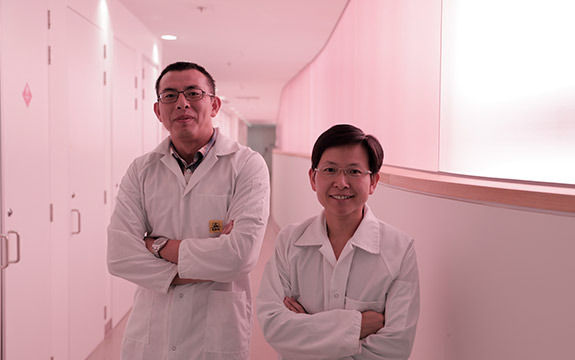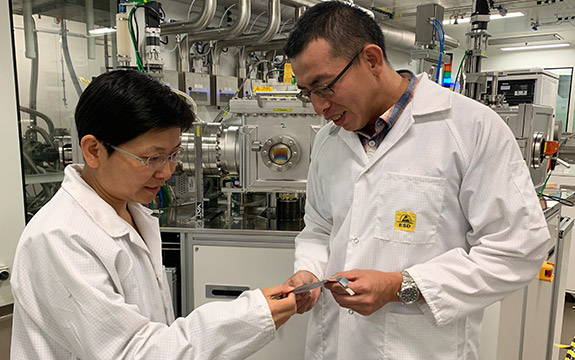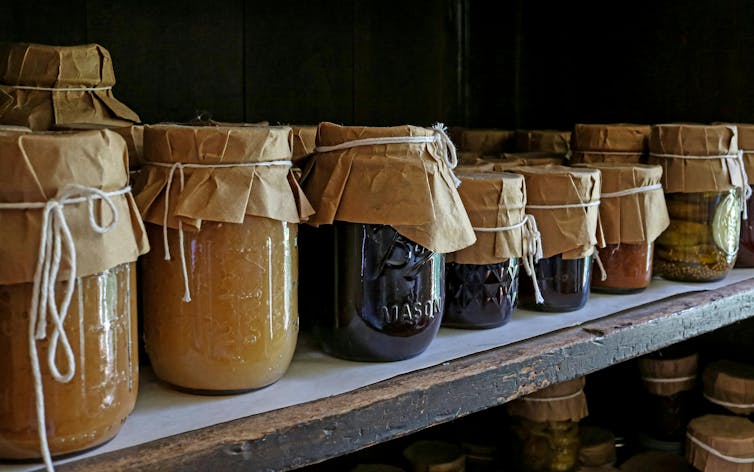
Professor Baohua Jia and Dr Han Lin from our Centre for Translational Atomaterials are using atomaterials to create new materials and products with never-before-seen functionalities.
You’ve likely heard of nanomaterials – the materials that make our devices and technologies small, fast and powerful. But have you heard of atomaterials?
‘Atomaterials’ is a term coined by Professor Baohua Jia, a nanotechnology expert and director of Swinburne’s new Centre for Translational Atomaterials.
“It’s a synthesised word from ‘atomic materials’ which are the next generation of nanomaterials,” says Professor Jia.
Think of atomaterials as the building blocks of nanomaterials. The atomic arrangement in the building blocks decides the properties of the blocks and the nanomaterials. These building blocks – the atomaterials – are tiny bricks made of atoms, about one millionth of a human hair in size.
What makes atomaterials so special?
Atomaterials open up a whole new world of science, says Professor Jia.
“It’s a bit like Lego,” she says. “Nanomaterials are like different pieces of Lego joined together, whereas atomic materials are the single pieces.”
The rapid progress in nanomaterials over the past 30 years has enabled miniaturisation and drastic performance improvement in many areas, including electronics, communications and manufacturing.
“But we will soon reach the limits of nanotechnology. For example, the property of silicon cannot sustain once it is pushed smaller than five nanometres.”
“Atomaterials however, can be reconstructed in intelligent ways to create new materials that outperform the old ones with functionalities never seen before.”
Graphene, discovered in 2004, is one example of an atomaterial and one which in developing for use in large-scale manufacturing and device development.

The centre’s Global Open Lab will enable industry and researchers to collaborate more easily and allow for the seamless translation of new technologies.
How will atomaterials change our world?
Using atomaterials, Swinburne researchers are creating new functionalities and products that will change our world and the everyday products we use. These include:
- A supercapacitor energy-storing device: This super battery made from graphene will charge devices in seconds and electric vehicles in minutes. It has a lifetime of millions of cycles because it doesn’t rely on a chemical reaction to work. It is also safer than current batteries, which are toxic to the environment.
- Ultrathin graphene solar heating: A material that can rapidly heat up to 160 degrees Celsius under natural sunlight in half a minute in an open environment. It could be used for solar energy harvesting, distilling sea water into clean drinking water for immediate consumption or to create more efficient hot water systems.
- Self-cooling film: A film that prevents the absorption of heat and can cool down the environment by up to 10 degrees without electricity. It could have applications for buildings or clothing and would reduce the use of electricity by 35 per cent, lessen the number of electricity blackouts in summer and reduce carbon dioxide emissions.
- Smart, sensory surfaces: Many atomaterials are sensitive to temperature, touch and other parameters. This team are exploring sensors that can be integrated into devices or immersed into environments to make them ‘intelligent’ when they are link to other technologies. For instance, it could be for the floors of aged care facilities to monitor if residents fall over or integrated into steering wheels to assess the driver’s grip of the wheel and prevent crashes.
Swinburne’s Dr Han Lin shares how he is using the ‘wonder material’ graphene to develop the game-changing supercapacitor energy-storing device.
The Centre for Translational Atomaterials
Swinburne’s Centre for Translational Atomaterials (CTAM) is the world’s first centre focused on atomaterial discovery, research and translation. An ‘open lab’ where industry and researchers can collaborate to allow for seamless translation of research to market makes the centre especially unique.
International Conference on Nanomaterial and Atomaterial Sciences and Applications
Swinburne will host the International Conference on Nanomaterial and Atomaterial Sciences and Applications (ICNASA) from 31 January – 3 February 2020.
During the conference, academic and industry representatives from around the world will exchange knowledge about the latest advances in material sciences and how they can be rolled out into industry and products.
If you’re interested in working with Professor Baohua Jia ([email protected]) and the team at the Centre for Translational Atomaterials, you can contact them through .








